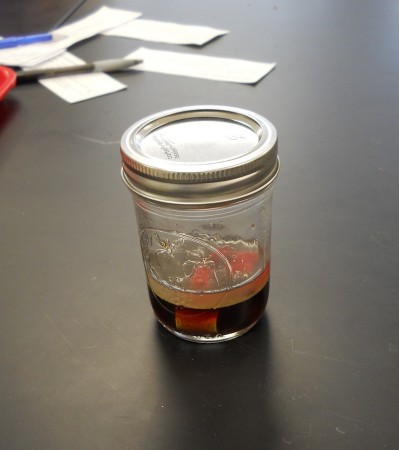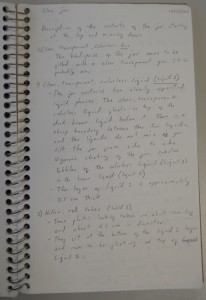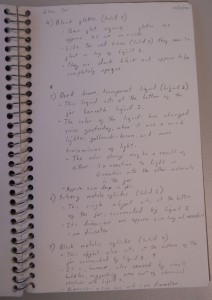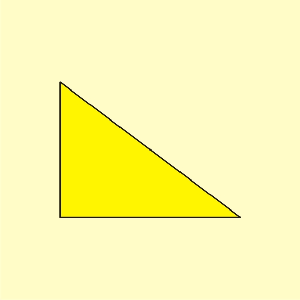Silvia Pelissero (aka Agnes-Cecile) brings a face to life in watercolor. (She has more, excellent videos on her YouTube channel).
Tag: epistemological
Science Starts with Careful Observation


The middle school started science this week with a mysterious jar of unknown substances: a couple immiscible liquids; some plastics and metals of different densities.
As they try to separate and identify the mixture they’ll be learning about handling potentially hazardous materials, material physical and chemical properties (like density and pH), and a little chemistry.
But the first thing they need to learn is how to take notes. Science starts (and ends) with observation. Careful observation. And most middle schoolers need mentoring to make sure their notes are rigorous.
To this end, after they wrote up their observations of what was in the jar, I put together my own notes as a general reference. This is not the only way to take notes, but I’m going to have them amend their own notes to make sure they’re neater and have as much detail as possible.


93 Ways to Prove Pythagoras’ Theorem

Elegant in its simplicity but profound in its application, the Pythagorean Theorem is one of the fundamentals of geometry. Mathematician Alexander Bogomolny has dedicated a page to cataloging 93 ways of proving the theorem (he also has, on a separate page, six wrong proofs).
Some of the proofs are simple and elegant. Others are quite elaborate, but the page is a nice place to skim through, and Bogomolny has some neat, interactive applets for demonstrations. The Wikipedia article on the theorem also has some nice animated gifs that are worth a look.
Cut the Knot is also a great website to peruse. Bogomolny is quite distraught about the state of math education, and this is his attempt to do something about it. He lays this out in his manifesto. Included in this remarkable window into the mind of a mathematician are some wonderful anecdotes about free vs. pedantic thinking and a collection of quotes that address the question, “Is math beautiful?”
Mathematics, rightly viewed, possesses not only truth, but supreme beauty — a beauty cold and austere, like that of sculpture, without appeal to any part of our weaker nature, without the gorgeous trappings of painting or music, yet sublimely pure, and capable of a stern perfection such as only the greatest art can show.
– Bertrand Russell (1872-1970), The Study of Mathematics via Cut the Knot.
Thinking Like a Cartoonist
The Guardian website has some very interesting glimpses into the mind of the artist, with a series of videos where Paul Trevillion describes his thought process as he draws different players for his You are the Ref strip.
How to Think Like a Mathematician
The epistemological approach to education suggests that the best way to learn a subject is to learn how to think like the experts in the field: how to think like a scientist; how to think like an historian; how to think like an engineer; etc.
How to think like a mathematician is Kevin Houston‘s attempt to explain how one mathematician at least approaches problems. To whet your appetite, he has a free pamphlet, 10 Ways To Think Like a Mathematician, which starts off with:
- Question everything, and
- Write in sentences
Logic is, apparently, quite important.
If you want to understand mathematics and to think clearly, then the discipline of writing in sentences forces you to think very carefully about your arguments.
— Kevin Houston: 10 Ways To Think Like a Mathematician
It’s an interesting introduction to how mathematicians see the world, and its a useful reminder that many of the ways of thought that apply to any field can be useful in other places, or even in life in general.